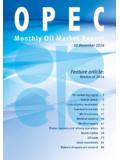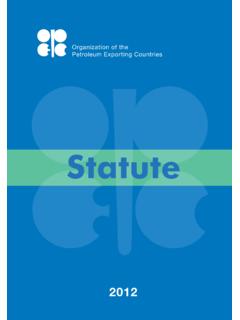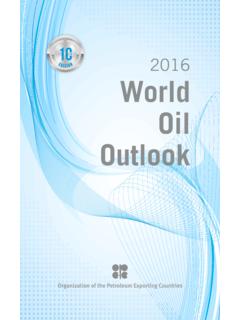Transcription of OPEC
1 monthly Oil market ReportOPEC13 February 2017 Feature article:Review of global oil demand trendOil market highlightsFeature articleCrude oil price movementsCommodity marketsWorld economyWorld oil demandWorld oil supplyProduct markets and refinery operationsTanker marketOil tradeStock movementsBalance of supply and demandMonthly endnotes13511153142586569778492 Organization of the Petroleum Exporting CountriesHelferstorferstrasse 17, A-1010 Vienna, AustriaE-mail: prid(at) : monthly Oil market report February 2017 1 Oil market Highlights Crude Oil Price Movements The OPEC Reference basket averaged $ in January, representing a gain of 73 over the previous month.
2 NYMEX WTI and ICE Brent also saw gains, increasing by 44 and 53 to average $ and $ , respectively. Production adjustments by OPEC and some non-OPEC producers supported the market , although gains were capped by increased drilling activity in the US. The Brent-WTI spread widened slightly to average $ in January. World Economy Global economic growth expectations remain at in 2016 and in 2017. OECD growth in 2017 was revised up to , following upward adjustments in the Euro-zone and UK. US economic growth remains unchanged at Forecasts for China and India in 2017 also remain unchanged at and , respectively. Russia s 2017 growth was revised up to , while Brazil s growth forecast remains unchanged at World Oil Demand World oil demand growth in 2016 is expected to increase by mb/d, following an upward adjustment of 70 tb/d to reflect continued better-than-expected consumption in OECD Europe and Asia Pacific.
3 Total oil demand is now estimated to average mb/d, taking into account base line adjustments to China of around mb/d. In 2017, world oil demand growth is seen to reach mb/d, representing an upward revision of 35 tb/d to now average mb/d. World Oil Supply Non-OPEC oil supply growth in 2016 has been revised up by 50 tb/d to now show a contraction of mb/d on higher-than-expected output in 4Q16. In 2017, non-OPEC supply growth has been revised up by 120 tb/d to now show an increase of 240 tb/d, due to a pick up in drilling activities and investment in the US. OPEC NGL production is forecast to grow by mb/d in 2017, following growth of mb/d in 2016.
4 In January, OPEC production decreased by 890 tb/d, according to secondary sources, to average mb/d. Product Markets and Refining Operations Product markets in the Atlantic Basin received support in January from the top of the barrel on the back of higher export opportunities in gasoline and naphtha. This, along with the positive performance at the bottom of the barrel, allowed refinery margins to remain healthy. Meanwhile, margins in Asia strengthened on the back of firm regional demand. Tanker market Spot freight rates continued to recover in January, showing general m-o-m improvements across all tanker sectors. Gains were mainly driven by a firmer market in West Africa, the Middle East and the Mediterranean, along with delays due to congestion in the Turkish Straits and severe weather conditions.
5 Freight rates rose in January, despite a general decline in chartering activity. Stock Movements Total OECD commercial oil stocks fell in December 2016 to stand at 2,999 mb. At this level, OECD commercial oil stocks are 299 mb above the five-year average. Crude and products showed surpluses of around 216 mb and 83 mb, respectively. In terms of forward cover, OECD commercial stocks stood at days, some days higher than the five-year average. Balance of Supply and Demand Demand for OPEC crude in 2016 averaged mb/d, an increase of mb/d over the previous year. In 2017, demand for OPEC crude is projected to average mb/d, around mb/d higher than last year.
6 2 OPEC monthly Oil market report February 2017 OPEC monthly Oil market report February 2017 3 Review of global oil demand trend World oil demand in 2016 continued its healthy performance for the second year, with growth set to be above mb/d. This growth is in line with our initial projection for the year in July 2015. However, revisions were made within the regions with upward adjustment in OECD Europe, OECD Asia Pacific and Other Asia. Oil demand in these regions performed better-than-expected particularly in the petrochemical and transportation sectors. The upward revisions were almost entirely offset by bearish oil consumption momentum in Latin America and Middle East as a result of stagnating economic activities and a high level of fuel substitution with natural gas.
7 In terms of oil products, road transportation fuels both gasoline and diesel oil were the largest contributors to 2016 oil demand growth, in line with high vehicle sales in major markets, particularly in Europe and China (Graph 1). Petrochemical feedstocks also received an extra push in 2016 as firm petrochemical margins globally as well as start-ups of propane dehydrogenation (PDH) plants in China lent support to the industry. Graph 1 Growth in vehicle sales for selected regions Graph 2 Oil demand growth In 2017, oil demand growth is assumed to remain healthy with potential growth estimated at mb/d, well above the ten-year average of mb/d (Graph 2). Several assumptions have been considered in 2017 projections.
8 Firstly, global economic activities are anticipated to rise by around with economic development in the OECD region rising solidly above 2016 levels. Secondly, road transportation is anticipated to continue to be the driving factor for oil demand growth in 2017, primarily as a result of anticipated high vehicle sales in the US, Europe, China and India. Thirdly, the expanding petrochemical sectors in US and China are projected to lend support to petrochemical feedstocks. On the other hand, efficiencies, supported by technological advancements, are forecast to partly hinder increases in transportation sector fuel requirements and to a lesser extent in the residential sector.
9 Potential reductions in subsidies are expected to have a negative impact on oil consumption. Additionally, substitution by other fuels is also accounted for in the 2017 oil demand projections. In terms of products, transportation fuels are anticipated to lead global growth in 2017 with the bulk of volumes being in the non-OECD. Gasoline consumption is seen contributing mb/d to the increase followed by jet/kerosene with mb/d and on-road diesel with mb/d. However, the projected growth in transportation fuels is expected to be smaller than in 2016, especially in India, where transportation fuels are projected to ease in the second half of the year, primarily as a result of the impact of the government s demonetisation policy and the higher baseline of comparison.
10 Petrochemical feedstock, which includes NGL, LPG and naphtha are projected to rise in both OECD and non-OECD countries with most of growth in non-OECD coming from China and India. As a result, OECD oil demand is anticipated to increase by around mb/d, with OECD Americas and Europe being firmly in the positive, while Asia Pacific is expected to continue to decline. The non-OECD, growth is expected to be around mb/d, with Other Asia being the major contributor. Oil demand growth is anticipated to be led by Other Asia followed by China and OECD Americas, while Asia Pacific is the only region expected to be in the negative territory in 2017. Any better-than-anticipated performance of the global economy together with less crude price volatility will support oil demand helping to accelerate the rebalancing in the oil market to the benefit of both consumers and producers.














